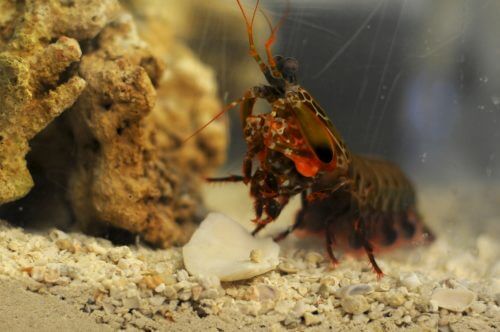Researchers are now closer to developing super-strong composite materials, thanks to the mantis mantis, a small, colorful marine crustacean that breaks apart the shell of its prey using a pincer-like appendage called a dactyl club. The researchers describe for the first time the unique structure of this supplement
![The Idra structure of the outer layer (impact zone) of the Hasilon [courtesy of UC Riverside]](https://www.hayadan.org.il/images/content3/2016/07/shrimp1-500x453.jpg)
Researchers are now closer to developing super-strong composite materials, thanks to the mantis mantis, a small, colorful marine crustacean that breaks apart the shell of its prey using a pincer-like appendage called a dactyl club. The researchers describe for the first time the unique structure of this supplement.
Researchers at the University of California are now closer to developing extremely strong composite materials, thanks to the mantis mantis, a small, colorful marine crustacean that breaks apart the shell of its prey using a pincer-like appendage called a dactyl club. The updated study, which is to be published in the scientific journal Advanced Materials, describes for the first time ever a unique hydra structure, which has never been observed in nature, within the outer layer of the hasilon. This hard structure not only protects the hawk's claws during the strike, but it is what allows it to cause great damage to its prey.
A mantis-type mantis exists in nature in two versions: 'striking' and 'stabbing'. While impaling snails kill their prey by thrusting a skewer into soft-bodied marine creatures, battering snails kill their hard-shelled prey, such as crabs and snails, by crushing them with high speed and force. As part of a previous study, including an article published in 2012 in the prestigious scientific journal Science, the researchers revealed several different areas in the organ called the dactyl club, including an internal area called the 'circulatory area', which contains an energy-absorbing structure that is also capable of warding off powerful waves that harm the marine animal . This energy-absorbing area consists of two parts: an organic area made of chitin (a fibrous material in the exoskeleton of arthropods) organized in a helical structure like a spiral staircase, and an inorganic material made of two amorphous salts: calcium phosphate and calcium carbonate.

The impact zone consists of a crack-resistant layer that protects against pinching while the slug hits its prey. However, unlike the circulatory area, the injury area consists of crystalline salt - the calcium phosphate (the same salt found in human bones) that wraps around the organic chitin fibers. The researchers found that these salt fibers were compressed in order to create a "spiral structure" that is much more rigid than the structures that make up the cyclic region. Despite the fact that the formation mechanism of this structure is still not clear enough, the researchers hypothesize that the difference in the pressures received during the formation of the crystalline material in the impact zone is the cause of obtaining the helical structure. In addition to these components, the outermost layer of the impact area is also different from the other layers, and consists of a thin coating around the clamps, which allows for the dispersion of the pressures affecting the outer layer. "From previous studies, we know that the impact zone allows the snake to transfer a considerable amount of momentum to its prey, while resisting the formation of fractures, but it was fascinating to discover in our research that the properties of this particularly pressure-resistant material stem from its unique structure," explains the lead researcher.
In order to confirm their hypothesis, the researchers created the Idra structure using synthetic materials and a XNUMXD printer. Even before that, they were able to develop computer models that reproduce the most precise details of the Idra structure. These models showed that damaging pressures may be distributed more uniformly in such structures, while preventing destructive structural failure. Compression tests of the synthetic material printed in the XNUMXD printer also proved that the structure of the idra makes the impact area even more efficient than the circular area in terms of dispersing the pressures and preventing the formation of cracks and fractures. The information obtained from this research could help in the future development of important innovative pressure-resistant materials in a variety of applications, including in the fields of space and aviation, automotive and armor.
The Idra structure of the outer layer (impact zone) of the Hasilon [courtesy of UC Riverside]
